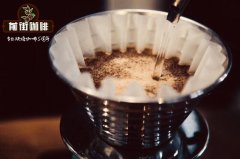Industrial Development of Coffee producing areas in Ecuador what are the characteristics of fine coffee in Ecuador

Professional coffee knowledge exchange more coffee bean information please follow the coffee workshop (Wechat official account cafe_style)
Coffee was introduced as a crop in 1860 when plantations were first established in the coastal areas of Manabi province in the Jipijapa region. Ecuador is famous for growing beans for instant coffee, which is still a staple food for many Ecuadorian families. Although large plantations still exist, recent Ecuadorian coffee production is shifting to smaller family farms and specialty beans.
The situation in Ecuador is changing. It is visible when you walk around the city square or on a mountain farm. You can smell it in the street; you can taste it on your tongue.
This is the third wave.
It took us a long time to get here, but it finally arrived-for producers and consumers. We used to say that coffee-producing countries were unprofessional, but this small South American country proved it wrong.
Let me show you the five major contributions of Ecuador's growing areas of expertise.
1. Coffee climate
Ecuador is not a major coffee producer-its neighbours, Colombia and Peru, rather than the spotlight. However, its position on the equator makes it an excellent place to grow coffee.
It is rich in volcanic soil, with temperatures between 20 and 30 °C, average rainfall of 1600 mm during the rainy season and an altitude of 6000 masl (we have the highest peaks in the world, you know).
This means that Ecuador has the ability to produce high-quality crops, as long as they are well cultivated and processed and will not be damaged by pests, disease or bad weather. All it needs is a professional spark.
two。 A passionate producer
In recent years, a small number of producers have successfully carried out professional practice. They have been studying agricultural practices and investing in techniques for processing, drying and storing beans. They have begun to work with small-grain varieties such as Typica, bourbon, SL-28,Catuai, and even replace other crops. They have also received public and private assistance, including local / national governments and international agencies.
All this has helped Ecuadorian producers improve the quality of their crops and become more competitive in international competitions and specialty coffee auctions. In fact, in April, Tony Querio won the Roaster championship in the United States, which was planted by JuanPe ñ an in Hacienda La Papaya, Ecuador.
Of course, not every producer becomes a professional. For most of them, this level of investment exceeds their economic and social resources. However, more and more better production methods are a promising trend-we expect this trend to continue.
Don Alfonso Bravo from Carchi
Don Alfonso Bravo from Carchi grows yellow and red Caturra,Typica and Castillo varieties. Photo: CarlosTob ó n
3. Local specialty roaster
Ecuador's best coffee is no longer sent directly overseas. Specialty coffee roasters began to appear in major cities such as Quito, Guayaquil and Cuenca. They use machines from companies such as Diedrich,Probat,Toper and San Franciscan Roaster Company.
Some of them, such as Traviesa Coffee Roasters, barbecue in their own retail stores, but most work in their own production facilities. Then their beans are sold in coffee shops and food markets in major cities.
Although there are only a few, the fact that specialty Ecuadorian coffee is roasted locally is fuelling the third wave.
Particularly worth mentioning are Traviesa, Caf é V é lez, Isveglio,Dulceria Colonial and Cafe Galletti.
4. The third wave of cafes
The microbubble flat-topped cappuccino is finished with the picture perfect for tulips and rosettas. The Brew bar is equipped with AeroPress,Chemex,V60 and even a siphon. Cold brewed coffee is suitable for hot summer. If you just know where to look, you'll find it in Ecuador.
In addition to a series of vibrant cafes serving the third wave of coffee, we have also seen some big brands of coffee equipment: Slayer,La Marzocco,Nuova Simonelli,Mahlk ö nig and Anfim.
It is worth mentioning that Ecuadorian cafes include:
Quito: Traviesa, the coffee college, Caff è of Isveglio,Xoco, True Caf é, Jincheng, Nanai Cafe, FjordCaf é en, about Intag, Cafe Galetti, El Cafeto,Dulceria Colony, Cafe Guayasamin, Caf é Cathedral, the Coffeeteer
Guayaquil: l ú dicaCoffeeHouse,Sailor Coffee,Masamadre
Cuenca: coffee é ucallacta, PuroCaf é Otavalo
: La Cosecha
Coffee is roasted with special barbecue. It is worth using special brewing method. Photo: CarlosTob ó n
5. Enthusiastic Ecuadorian barista
This year is the third consecutive National Barista Championship and the first National AeroPress Championship in Ecuador. John Romo of Lucia Cafe won the latter, and Diego Mejia will now compete in the World baristas Championship for the second time (learn how to broadcast live or watch the 2015 regular season here).
In the past, baristas were just doing their jobs; now they often see them actively competing for lattes and offering wise advice to customers on beans.
As baristas become more enthusiastic, they seek more knowledge, they gain more experience, and they become better baristas. And, most importantly, they are pushing consumers to recognize the person behind the counter-and the person who serves them.
Passionate baristas are the last aspect of this five-part system that pushes Ecuadorian coffee culture forward-towards higher quality, towards innovation, and towards the third wave.
Important Notice :
前街咖啡 FrontStreet Coffee has moved to new addredd:
FrontStreet Coffee Address: 315,Donghua East Road,GuangZhou
Tel:020 38364473
- Prev

Hawaiian coffee, Hawaiian coffee.
Professional coffee knowledge exchange More coffee bean information Please pay attention to coffee workshop (Weixin Official Accounts cafe_style) Hawaii Kona coffee beans are the most beautiful coffee beans in the world, it is unusually full, and bright luster, Kona coffee beans are evenly shaped, with strong sour and sweet taste, wet smooth, smooth taste. Because it grows on volcanoes, Hawaii is unique
- Next

Where does Jamaican coffee produce Blue Mountain Jamaica Blue Mountain Coffee? why is it delicious and popular?
Professional coffee knowledge exchange more information about coffee beans Please follow the coffee workshop (Wechat official account cafe_style) the Blue Mountains in central Jamaica is an extraordinary sight. The higher reaches of the river are almost eternal fog, and the tropical sun gives it an otherworldly internal light, as if the light itself had fallen on the trees. The heavy fog slowed the development of coffee and produced more coffee than its
Related
- Does Rose Summer choose Blue, Green or Red? Detailed explanation of Rose Summer Coffee plots and Classification in Panamanian Jade Manor
- What is the difference between the origin, producing area, processing plant, cooperative and manor of coffee beans?
- How fine does the espresso powder fit? how to grind the espresso?
- Sca coffee roasting degree color card coffee roasting degree 8 roasting color values what do you mean?
- The practice of lattes: how to make lattes at home
- Introduction to Indonesian Fine Coffee beans-- Java Coffee producing area of Indonesian Arabica Coffee
- How much will the flavor of light and medium roasted rose summer be expressed? What baking level is rose summer suitable for?
- Introduction to the characteristics of washing, sun-drying or wet-planing coffee commonly used in Mantenin, Indonesia
- Price characteristics of Arabica Coffee Bean Starbucks introduction to Manning Coffee Bean Taste producing area Variety Manor
- What is the authentic Yega flavor? What are the flavor characteristics of the really excellent Yejasuffi coffee beans?

